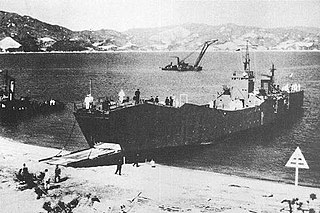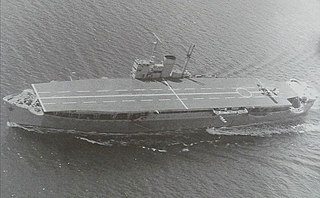
High-speed transports were converted destroyers and destroyer escorts used in US Navy amphibious operations in World War II and afterward. They received the US Hull classification symbol APD; "AP" for transport and "D" for destroyer. In 1969, the remaining ships were reclassified as "Fast Amphibious Transports", hull symbol LPR.

Landing craft are small and medium seagoing watercraft, such as boats and barges, used to convey a landing force from the sea to the shore during an amphibious assault. The term excludes landing ships, which are larger. Production of landing craft peaked during World War II, with a significant number of different designs produced in large quantities by the United Kingdom and United States.

Landing Ship, Tank (LST), or tank landing ship, is the naval designation for ships first developed during World War II (1939–1945) to support amphibious operations by carrying tanks, vehicles, cargo, and landing troops directly onto a low slope beach with no docks or piers. The shallow draft and bow doors and ramps enabled amphibious assaults on almost any beach.

Ōi (大井) was the fourth of five Kuma-class light cruiser, which served in the Imperial Japanese Navy during World War II. She was named after the Ōi River in Shizuoka prefecture, Japan. Designed as a command vessel for a destroyer squadron, she was converted into a torpedo cruiser with forty torpedo launch tubes in a plan abandoned by the Japanese Navy in 1942. During most of the Pacific War, she was used primarily as a fast troop transport and was sunk by a United States Navy submarine in 1944.

Kitakami (北上) was a Kuma-class cruiser in the Imperial Japanese Navy, named after the Kitakami River in Iwate Prefecture, Japan.

The Kuma-class light cruisers were a class of five light cruisers built for and operated by the Imperial Japanese Navy (IJN). The Kuma-class cruisers proved useful in combat operations ranging from the Aleutian Islands to the Indian Ocean throughout World War II.

The Momi-class destroyers were a class of twenty-one second-class destroyers of the Imperial Japanese Navy. All were named for plants. Obsolete by the beginning of the Pacific War, the Momis were relegated to mostly secondary roles, with some vessels serving throughout the war as patrol vessels or high speed transports.

The Daihatsu-class or 14 m landing craft was a type of landing craft used by the Imperial Japanese Army from 1937 to 1945, in the Second Sino-Japanese War and World War II. It was designated the "Type A" landing craft by the United States.
The Chuhatsu (中発) or 13m landing craft was a type of landing craft, used by the Imperial Japanese Navy during World War II. It was a smaller version of the Daihatsu Class, with a bow ramp that was lowered to disembark cargo upon riding up onto the beach.
The Shohatsu (小発) or 10m landing craft was a small landing craft used by the Imperial Japanese Army during World War II. It was used for landing personnel and stores. It was designated the "Type B" landing craft by the United States.

Kumano Maru (熊野丸) was a landing craft carrier with a full-length flight deck built for the Imperial Japanese Army (IJA) during World War II. Completed in early 1945, fuel shortages meant that the ship never became operational during the war. She was turned over to the Allies at Kure when Japan surrendered later that year. Before beginning to repatriate Japanese troops home, Kumano Maru was disarmed and modified to facilitate that mission. The ship continued to do so until she was sold for scrap in 1947.

The No.101-class landing ships were a class of amphibious assault ships of the Imperial Japanese Navy (IJN) and Imperial Japanese Army (IJA), serving during and after World War II. The No.101 class ships were powered by diesel engines, while the similar No.103-class landing ships were powered by a steam turbine engine. The IJN called them 2nd class transporter. The No.103 class included the IJA's SB craft variant. This article handles them collectively.

The No.1-class landing ship was a class of amphibious assault ships of the Imperial Japanese Navy (IJN), serving during and after World War II. The IJN also called them 1st class transporter.

Shinshū Maru was a ship of the Japanese Imperial Army during World War II. She was the world's first landing craft carrier ship to be designed as such, and a pioneer of modern-day amphibious assault ships. During some of her operations, she was known to have used at least four cover names, R1, GL, MT, and Ryujo Maru.
The Maritime Heritage Trail – Battle of Saipan is located within the protected waters of Saipan lagoon in the Northern Marianas archipelago. The majority of the dive sites including two Japanese shipwrecks, two Japanese aircraft, two US aircraft, a US landing vehicle and two Japanese landing craft can be found in the clear waters between Garapan, Tanapag Harbor, and Mañagaha Island while further south in Chalan Kanoa Lagoon there are three US tanks.
The Moku Daihatsu Class or 15m landing craft was a type of landing craft, used by the Imperial Japanese Army during World War II. It was similar to the Landing Craft, Vehicle, Personnel (LCVP), with a bow ramp that was lowered to disembark cargo upon riding up onto the beach. It was constructed of a plywood hull and powered by a gasoline engine.

Landing craft carriers or landing craft depot ships were an innovative type of amphibious warfare ship developed by the Imperial Japanese Army during World War II. The prototype was developed in secrecy under the pseudonyms Ryujo Maru and Fuso Maru using features later adopted by other navies for dock landing ships and amphibious transport docks. Additional ships were built after combat experience validated the concept, but most were completed after the Japanese invasions of the early war, and used primarily as troopships during later operations. Today's amphibious assault ships bear a strong similarity to this concept.

The Soukoutei class or AB-tei class was a type of armored gunboat used by the Imperial Japanese Army from 1928 to 1945 in the Second Sino-Japanese War and World War II. It was constructed of a metal hull and powered by a diesel engine. It was designated the "Type C" landing craft by the United States.

No. 1 was a No.1-class landing ship of the Imperial Japanese Navy during the Pacific War. Completed in early 1944, the ship was used as a convoy escort on one successful mission to resupply Imperial Japanese Army units on Saipan. On the return trip, No. 1 was badly damaged by American aircraft and towed to Palau. Redesignated as an anti-aircraft ship, she was sunk by American bombers in July 1944.














